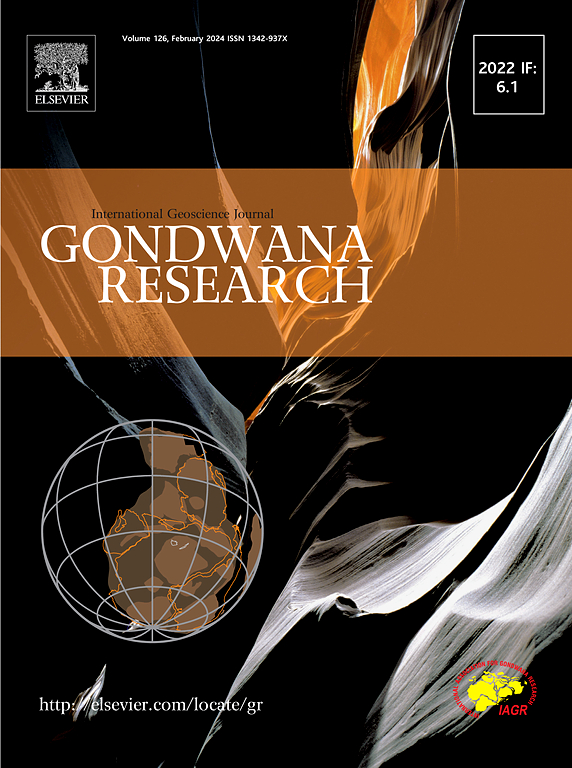Two magmatic-hydrothermal events in Xinzhai Sn polymetallic deposit, Yunnan Province, China: Constraints from cassiterite U-Pb geochronology and elemental compositions of single fluid inclusions
IF 7.2
1区 地球科学
Q1 GEOSCIENCES, MULTIDISCIPLINARY
引用次数: 0
Abstract
The Southeast Yunnan district is marked by multiple stages of magmatism, metamorphism, and early Paleozoic to Late Cretaceous Sn-W polymetallic mineralization. Numerous large to giant Sn-W deposits have developed and are closely related to skarns. Nevertheless, whether these skarns were contemporaneous with the Sn mineralization (economic skarn) or were superimposed on later tectonic events (noneconomic skarn) and whether the Sn polymetallic deposit formed from co-enrichment of Sn-In-Zn-Cu or enrichment of Sn-In superimposed by a separate Zn-Cu mineralization event remains poorly constrained. The Xinzhai deposit simultaneously developed Sn polymetallic mineralization and skarns (with Zn-Cu mineralization), making it a natural laboratory for exploring the mechanisms. Geological studies reveal that the Xinzhai deposit contains two separate hydrothermal systems: Sn-bearing hydrothermal veins (∼2.09 wt% Sn grade) and Sn-barren but sulfide-rich skarns (<0.04 wt% Sn grade). Three generations of cassiterite (Cst1-Cst3) were identified within the Sn-bearing hydrothermal vein. Cst1 and Cst2 are overprinted by newly formed Cst3, resulting in extensive microporosity filled by zoisite, biotite, and Zn-Cu sulfides. Cst3 differs from Cst1-2 in composition (e.g., Zr/Hf, W/Fe, Ti/Sc, Nb/Ta, W, and U) and fO2, indicating a different origin. LA–ICP–MS U–Pb dating of Cst1 and Cst2 yielded ages of 428.1–425.8 and 416.8–411.3 Ma, respectively. In situ Rb–Sr dating of biotite, contemporaneous with Cst3, yielded an age of 203.9 ± 5.3 Ma. These ages suggest that primary Sn mineralization (Cst1-2) and metasomatic fluids (formed Cst3, retrograde skarn, and Zn-Cu sulfides) originated from the Caledonian and Indosinian orogenic episodes, respectively. Fluid inclusion studies suggest that the Caledonian Sn-bearing fluid has higher homogenization temperatures, salinities, and metal compositions than Indosinian metasomatic fluids. Caledonian Sn-bearing fluids display higher δ34S values of sulfides (−2.34 to − 0.45 ‰) than Indosinian metasomatic fluids (−7.87 to 1.09 ‰). Based on geologic, textural, mineralogical, and geochemical evidences, we suggest that the Caledonian Sn polymetallic event was overprinted by Indosinian skarn and Zn-Cu mineralization episodes in the Xinzhai deposit. Caledonian Sn mineralization fluids were most likely inherited from the exsolution of granitic magma that intruded at ca. 430 Ma, whereas the Indosinian fluids probably derived from the metamorphic devolatilization of the Caledonian gneissic granites. This study further highlights that distinguishing the economic potential and noneconomic skarns in a hydrothermal system is crucial for Sn-Zn-In exploration.
云南新寨锡多金属矿床两次岩浆-热液事件:锡石U-Pb年代学约束及单流体包裹体元素组成
滇东南地区发育多期岩浆作用、变质作用和早古生代至晚白垩世Sn-W多金属成矿作用。区内已发育多处大、巨型锡钨矿床,与矽卡岩关系密切。然而,这些矽卡岩是与锡成矿同时期(经济矽卡岩)还是叠加在后来的构造事件上(非经济矽卡岩),以及锡多金属矿床是由Sn- in -Zn-Cu共富集形成还是由单独的Zn-Cu成矿事件叠加而成。新寨矿床同时发育锡多金属成矿和矽卡岩(含锌铜成矿),是探索成矿机制的天然实验室。地质研究表明,新寨矿床包含两个独立的热液体系:含锡热液脉(~ 2.09 wt% Sn品位)和贫锡富硫化物矽卡岩(<;0.04 wt% Sn品位)。在含锡热液脉中发现了3代锡石(cst1 ~ cst3)。Cst1和Cst2被新形成的Cst3叠印,形成广泛的微孔隙,由黝帘石、黑云母和锌铜硫化物填充。Cst3与Cst1-2的组成(如Zr/Hf, W/Fe, Ti/Sc, Nb/Ta, W和U)和fO2不同,表明其来源不同。Cst1和Cst2的LA-ICP-MS U-Pb年龄分别为428.1 ~ 425.8 Ma和416.8 ~ 411.3 Ma。与Cst3同时期的黑云母原位Rb-Sr测年结果为203.9±5.3 Ma。这些年龄表明,原生锡成矿(Cst1-2)和交代流体(形成于Cst3、逆行矽卡岩和锌铜硫化物)分别起源于加里东期和印支期造山期。流体包裹体研究表明,加里东期含锡流体比印支期交代流体具有更高的均一温度、盐度和金属成分。加里东期含锡流体的硫化物δ34S值(−2.34 ~−0.45‰)高于印支期交代流体(−7.87 ~ 1.09‰)。综合地质、构造、矿物学和地球化学证据,认为新寨矿床的加里东期锡多金属事件叠加了印支期矽卡岩和锌铜成矿事件。加里东期锡成矿流体很可能继承自约430 Ma侵入期花岗质岩浆的析出,而印支期锡成矿流体则可能来自加里东期片麻质花岗岩的变质脱挥发作用。该研究进一步强调了在热液系统中区分经济潜力矽卡岩和非经济矽卡岩对Sn-Zn-In的勘探至关重要。
本文章由计算机程序翻译,如有差异,请以英文原文为准。
求助全文
约1分钟内获得全文
求助全文
来源期刊

Gondwana Research
地学-地球科学综合
CiteScore
12.90
自引率
6.60%
发文量
298
审稿时长
65 days
期刊介绍:
Gondwana Research (GR) is an International Journal aimed to promote high quality research publications on all topics related to solid Earth, particularly with reference to the origin and evolution of continents, continental assemblies and their resources. GR is an "all earth science" journal with no restrictions on geological time, terrane or theme and covers a wide spectrum of topics in geosciences such as geology, geomorphology, palaeontology, structure, petrology, geochemistry, stable isotopes, geochronology, economic geology, exploration geology, engineering geology, geophysics, and environmental geology among other themes, and provides an appropriate forum to integrate studies from different disciplines and different terrains. In addition to regular articles and thematic issues, the journal invites high profile state-of-the-art reviews on thrust area topics for its column, ''GR FOCUS''. Focus articles include short biographies and photographs of the authors. Short articles (within ten printed pages) for rapid publication reporting important discoveries or innovative models of global interest will be considered under the category ''GR LETTERS''.
 求助内容:
求助内容: 应助结果提醒方式:
应助结果提醒方式:


